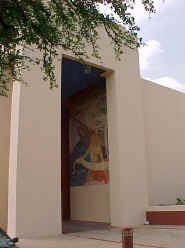 Local consolidation of insecure paint will be performed in all unstable areas but especially in areas of exposed original paint. Richard Wolber’s suggests dispersion consolidants (such as Beva D8 or Rhoplex acrylic adhesive) as they accommodate expansion and of paint and ground layers. Perry Huston suggests that a wax consolidant may be the best option given the need to help isolate the outdoor mural from climatic conditions. A combination of microcrystaline wax, acrylic dispersions and polyvinyl acetates in solvents will be required to meet the various conditions of cleavage and penetrability of the paint layers and support. Some of these consolidants will require local applications of heat and pressure. Thorough rinsing of excess adhesive from the surface will be required.
Local consolidation of insecure paint will be performed in all unstable areas but especially in areas of exposed original paint. Richard Wolber’s suggests dispersion consolidants (such as Beva D8 or Rhoplex acrylic adhesive) as they accommodate expansion and of paint and ground layers. Perry Huston suggests that a wax consolidant may be the best option given the need to help isolate the outdoor mural from climatic conditions. A combination of microcrystaline wax, acrylic dispersions and polyvinyl acetates in solvents will be required to meet the various conditions of cleavage and penetrability of the paint layers and support. Some of these consolidants will require local applications of heat and pressure. Thorough rinsing of excess adhesive from the surface will be required.
The multiple layers of latex overpaint and the tenacious oil paint layer will be softened and “rubberized.” Once rubberized, the layers will be lifted off the surface. The original paint is soluble at a different rate than the layers of overpaint thereby making the separation of the layers possible. This removal technique will avoid redissolving the paint layers with repeated applications of solvents, thereby avoiding the penetration of the dissolved paints into the mural’s degraded structure. Thorough rinsing with an appropriate solvent will be required. Removal of the tenacious first layer of over-paint and discolored varnish coatings from the mural’s surface may not be complete and a residual may be left behind in the cleaning process to ensure the safety of the surrounding areas of original paint.
Once the original painting layers are exposed, a follow up treatment of the consolidation process may be required in some areas.
The wires and other foreign attached materials will be removed and the holes in the substrate repaired with fill materials. Other losses in the support surface and some deeper losses will also require fills.
Prior to inpainting, an isolating varnish will be applied. The varnish will provide appropriate saturation and sheen in keeping with the original intent of the artist.
At this point, the murals along the Esplanade on the Centennial building will be evaluated along side each other to compare and evaluate to what level should the retouching or compensation be performed. All the murals will be inspected together in order to get a uniform reading of their appearance.
Losses will be compensated with Golden MSA colors, an easily reversible, stable inpainting material. Conservation standards and the AIC Code of Ethics requires that as much original paint and what remains of the artist’s concept be retained as possible. This must be achieved without imposing interpretation and contemporary values upon the original work. Important clues to the original colors must be preserved. The “retouching phase” will not make the murals look new and, in fact, certain affects of aging must be accepted. Normal aging cracks will not be inpainted nor disguised; only large open cracks and inflicted damage. Inpainting will not make the damage or filled area disappear, but will help it to blend into the colors and composition readily. Aeroplane Transportation will read well to the public viewer at it’s normal viewing distance and areas of damage will not stand out.
Finally, an appropriate, stable, final varnish may be applied to the surface. Tests will be performed over the duration of the project to help evaluate which varnish qualities will perform the best for these murals at this location.
Other Tests During the Project
Besides the coating questions already mentioned, the extended period of the performance of this project afford us the possibility to closely monitor other conditions. Fading tests can be undertaken to determine the resistance of the original paint layers and the inpainting materials to the environment. Observations of the direct exposure of the painting to sunlight and other atmospheric conditions can be recorded. These results will aid in determining the protection required following conservation treatments.
Short Term and Long Term Maintenance Requirements
Once completed, the murals are not expected to receive on going maintenance. However, the popular concept of “restoring” art pieces “once and for all” by treatment is an erroneous, misleading and dangerous concept. On going protection of the murals is extremely important, but any techniques/ structures to accomplish this must be maintenance free. It is not within the scope of this project to physically confront this issue. However, proposals will be made and consultation is available. Periodic inspection by trained and qualified personnel will aid in the maintaining and confronting of the mural’s conditions as they arise.
This report is part of a Conservation Treatment Proposal which will be updated and expanded as the projects develops. This modified in-depth report complete with photography will make up the final reports.
FACL, Inc. will work with the appropriate City of Dallas or Fair Park or Park and Recreation departmental personnel to develop educational ideas. No specific educational responsibilities are outlined in the contract for this work beyond our collaboration for the “educational component to be determined.”
